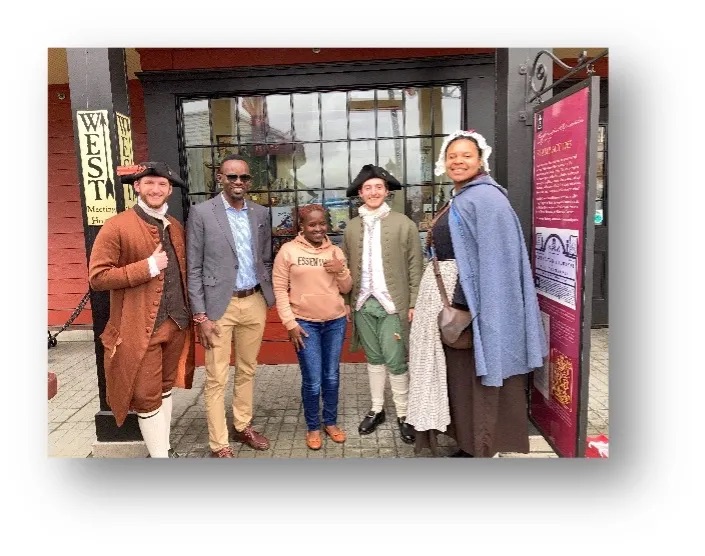Reflections on My Disability Inclusion Journey and Visit to the USA
Published: Jul 17, 2023
Country: Kenya
Sande Erick is a 2023 Fellow in the Professional Fellows Program on Inclusive Civic Engagement. This program is sponsored by the US Department of State’s Bureau of Educational and Cultural Affairs and is administered by the Institute for Community Inclusion (ICI) at the University of Massachusetts Boston in partnership with Humanity and Inclusion (HI). The following blog post was written by guest author Sande Erick.
Memories of my Stammer
I have stammered for as long as I can remember. Going through high school in Kenya was difficult. My peers were insensitive and openly made fun of my speech impediment, mimicking the unpleasant sounds I made when speaking. To date, I still experience mockery and stigma attributed to my stammer. However, my lived experience has given me an opportunity to be a changemaker in my community, advancing an inclusive environment for persons with disabilities.
Boston Encounter
Throughout my life and with Joe Biden’s presidency and the story of his struggle with a stutter, I developed an urge to visit the US. Today, as a champion for disability inclusion and a visiting fellow, I am so delighted for the opportunity to experience the US and exchange inclusive civic engagement practices.
When I arrived at the Boston Logan International Airport, Heike and Christa, two members of the Professional Fellows Program (PFP) team, were already waiting for me. As we drove off to the hotel, seated by the window, I notably observed the accessibility features in the built world. All this while Heike shared interesting sites that Clara, a visiting PFP Fellow from Tanzania, and I could visit in Boston before our orientation at the Institute for Community Inclusion (ICI). We got an opportunity to sightsee around Boston together, visiting Harvard University, the Boston Tea Party Boat, Faneuil Hall, Boston Public Library, and the Massachusetts Statehouse, whilst following the Freedom Trail through the Boston Public Garden.

I was puzzled by what seemed like deliberate efforts to make the built surrounding inclusive. Public transport is explicitly accessible, with disability signage all over the streets. When we visited the Boston Public Library, I noticed a person using a wheelchair navigating the library all by himself. For me, it spoke volumes to the accessibility of the built environment.

Later, at the orientation, I got to interact and exchange experiences with advocates and experts in disability inclusion, representing different organizations in Massachusetts. I got to appreciate that the milestone in disability inclusion, spanning from the built environment to social inclusion, is a result of years of consistent advocacy work by persons with disabilities and their organizations. Even so, full inclusion is yet to be realized.
Inclusion in Alaska
I write this one week into my Fellowship exchange program at the University of Alaska Anchorage (UAA), the Center for Human Development (CHD). My mentor is Kelley Hartlieb. She’s an amazing person with a wonderful family that made me feel at home within the shortest time possible. Landing at Anchorage International Airport, Kelley and her family picked me up in a typical American truck, a Toyota Tacoma. In no time we arrived at my new home, and I learned so much about the city of Anchorage and the Chugach mountains from Kelley and her family’s narration during the drive.
Kelley and the CHD team have been instrumental in providing professional support and introducing me to pertinent organizations with expertise in matters of disability. First, I participated in a virtual series session put on by the Disability Abuse Response Team (DART) that was focused on removing barriers and increasing capacity to effectively address substance abuse survivors with disabilities. I found this interesting and peculiar at the same time. Substance use is increasingly becoming a menace, yet, back at home, little attention is given to this subject, especially among the disability community.
I also took part in a virtual meeting with a consortium of organizations for persons with disabilities in Alaska. During this meeting, the consortium reviewed different policies and bills directly impacting the disability community in Alaska. I’m amazed at how organizations of persons with disabilities have made significant contributions to the policy space. I am currently watching Crip Camp, a documentary about the disability movement in the US, to get an understanding of the historical perspective and contribution of renowned individuals like Judy Heumann who is considered the “mother of the disability movement.”
This fellowship has been an opportunity to reflect on my disability inclusion journey, appreciating the strides I’ve made while staying cognizant of the bigger inclusion picture for all.
 The Professional Fellows Program on Inclusive Civic Engagement
The Professional Fellows Program on Inclusive Civic Engagement